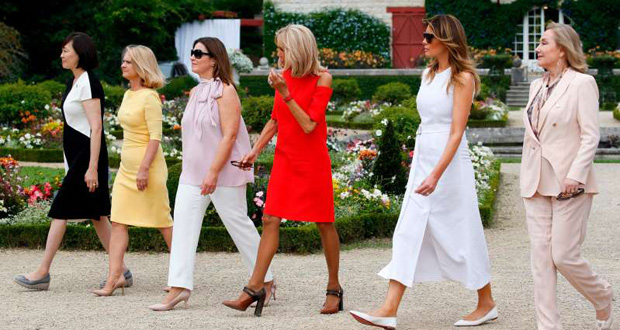Publicité
Looking through the political showcase
Par
Partager cet article
Looking through the political showcase

At the last G7 summit, the picture of 17 heads of states comprising 16 men and one woman, who will likely not stay in her leadership position for long, was a striking contrast to the picture of the first ladies in pretty frocks walking around the flower gardens. At the Language, Gender and Leadership Network conference (LGLN) at the University of Nottingham last week, this pictorial contrast made a good point of entry for my discussion with colleagues from UN Women, the Institute for Social Transformation, colleagues from various sectors from banking to politics, academia and entrepreneurship. Not only were the power dynamics of the two pictures a stark reminder that gender parity has rescinded further into a future we will not see (108 years according to the World Economic Forum) but Trump vented out his annoyance at Macron for veering the summit towards ‘two niche areas’, climate change and gender issues. For fans of Game of Thrones, you will remember the costly silliness of kings and queens fighting the wrong battles and the wrong enemies until it was too late. Unless we have a sustainable planet to host us, the height of the segregating walls we build will matter little. Sustainable also means empowering our human capital so we can better tackle the challenges ahead.
Simon Gallow, Development Director of UN Women UK, a passionate advocate for gender parity at LGLN, made the well-established point that structural barriers stopping girls and women from achieving their potential is not a women’s issue, it is a human issue, it is one of sustainability. Most global business leaders get the point that diversity leads to more innovation and productivity. PWC shifted the representation of women on their global leadership team from 18% to 47% in 15 months. Vodafone are aiming to connect 50 million women in emerging markets to mobile by 2025.
With figures likes these, I’m thinking, surely, we will not have to wait a whole century. ‘But wait,’ he says, ‘diversity is about counting heads. Inclusion is about making heads count.’ I love this point, it reminds me that the G7 pics were neither counting heads nor making them count. ‘Also the mind argument has been won’, he continues. ‘But not the heart argument.’
“Most global business leaders get the point that diversity leads to more innovation and productivity.”
These two points strike a chord with me in relation to my own work of building leadership capacity for women in organisations in East Africa. My observations correlate with his. Clearly, global businesses are catching up on the advantages of gender equality. They are investing in events designed to encourage more women to join STEM-related jobs, in leadership coaching programmes to encourage women to aspire to increasingly senior positions in the organization, let alone in lavish celebrations of International Women’s Day. True, more and more companies are aligning their values to gender parity. The number of women in nontraditional sectors and in senior positions is increasing. All are laudable efforts. But from my work on the LGLN, I have also picked up that the very organisations, which highly publicise their pledge to inclusion and diversity – or perhaps to diversity and not to inclusion – actually harbour internal structures which will also inhibit young women from reporting sexual harassment in the workplace especially if the perpetrator is from the C suite. The fear from young women to speak up against sexually abusive men in positions of power in the organization is not surprising. It is the old but real fear of reprisals, the fear of a connivance between the people they should be speaking to in Human Resources/ Legal and the leadership, the fear that their words will be discounted against the words of those who hold power. These internal structures take time to create, they are invisible, unpalpable but, once established, they work to almost perfection with the tacit understanding of a handful. I have heard testimonies of young women who suffer from post-traumatic stress disorder, choosing to choke on their own silence rather than denounce. To get the numbers in is mere diversity. To ensure that internal structures are respectful, to ensure an environment where the reporting of abuse is safe, to make the heads and the voices count, that would be inclusion.
Simon Gallow is right, we have yet to win the ‘heart argument’ in driving the equality agenda. As the HeforShe movement becomes more glamourized, there is the risk that some of the organisations which want to jump onto the diversity bandwagon may continue to hide manipulation behind the discourses of equality, as if the latter were pretty frocks in a floral garden. For those of us working on gender parity in the workplace, ensuring leadership commitment is a quick win. Ensuring leadership accountability is the real challenge.
Publicité
Publicité
Les plus récents






